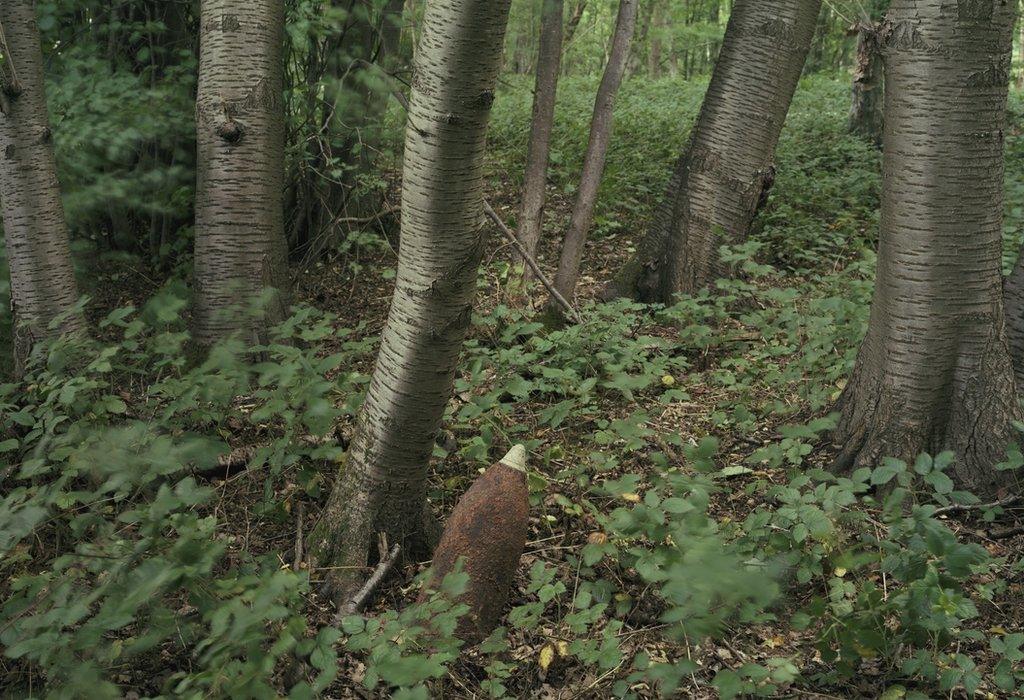Mametz Wood: Haunting photos show scars left behind
- Published

A shell pokes out of the dense undergrowth in the wood which was a battleground in World War One
The signs of war are still visible in live ammunition shells being pushed up by the roots of trees.
They are clear in the rotting leather of the boots of soldiers, now a part of the undergrowth.
And, 100 years since one of the key strategic battles of the Somme, the detritus of war is still being uncovered by nature in Mametz Wood.
Photographer Aled Rhys Hughes has captured the haunting history of the wood in a series of pictures.
The battle of Mametz Wood was the first major battle of World War One for many Welsh soldiers, with 3,993 killed or injured there.
The woods were left a muddy mess of bodies and broken trees.
A century later rusting shells still remain stuck between branches, while others are uncovered by farmers ploughing the fields which also formed part of the battleground.
One tree acts as a place for visitors to leave memorials to those who fought in the woods
Live shells and detonators are unearthed by tree roots as army boots are nestled between tree trunks above
The wood in northern France, nearly a mile wide and more than a mile deep, was strategically important for the Allied Forces in the Battle of the Somme.
The 38th (Welsh) Division spent five days trying to take the woods from German soldiers firmly entrenched there, and the haunting photographs show how the evidence of war in the woods has remained.
Mr Rhys Hughes, from the Rhondda, has visited Mametz Wood every summer for the last five years photographing the landscape for a book on how the woodland still reflects the events of July 1916.
His annual visits started in 2009 after he made a snap decision to visit the wood while on holiday in France.
"I was immediately taken hold of by the place, or rather the place took hold of me," said the photographer.
"On my way home I decided to stay for a couple of days and I took about 20 pictures, which is a lot for me as I shoot with a more traditional, old camera.
"The place seemed to have an atmosphere that I wanted to get across. I was there and although I was in France I felt like I was in Wales, there was a connection."
Farmers ploughing in the fields have uncovered countless shells
A shell stays wedged in a tree, a century after the battle took place
The Welsh soldiers were just seven months out of training when they entered into combat at Mametz Wood. Many had never fired a round in combat, and used broomsticks rather than rifles at drill practice.
In sharp contrast they faced the elite Lehr Regiment of Prussian Guards - highly-trained professional soldiers who were deeply entrenched in the dense woods.
Their trenches were dug into chalk and thick wire stretched through the battleground, while the wood was heavily fortified with machine guns.
It took the 38th (Welsh) Division five days to penetrate the woods.
On his walks through the 200 acres (80 hectares) of undergrowth the photographer found various kinds of ammunition as well as grenades and detonators.
The maze of bunkers that made up the German headquarters is still evident
A memorial to the Welsh soldiers who were injured and died hangs in one of the trees
He said: "I went into the forest and was walking along and there was a live shell there. I remember seeing it and I couldn't believe that it had been there since the First World War, but there must have been so many ammunition shells fired there it would be impossible to clear.
"On other occasions I found the roots of the trees pushing shells and other things up out of the ground."
Wartime bunkers, dug by both sides to protect the land gained, run through sections of the wood, now covered with a carpet of green.
"There are clear remnants there from the war, you can see crater holes and the remains of trenches," said Mr Rhys Hughes.
"It felt eerie. I felt like I was documenting an event that happened 100 years ago."
A Welsh flag imprinted on one of the trees in the wood
Photos featured are part of an exhibition at the National Library of Wales running until 3 December 2016
- Published7 July 2016
- Published30 April 2016